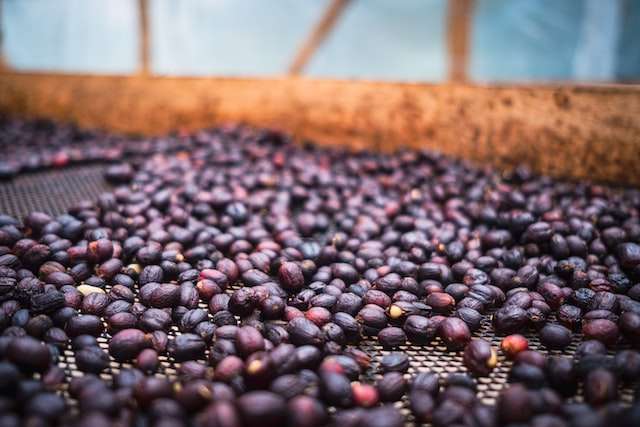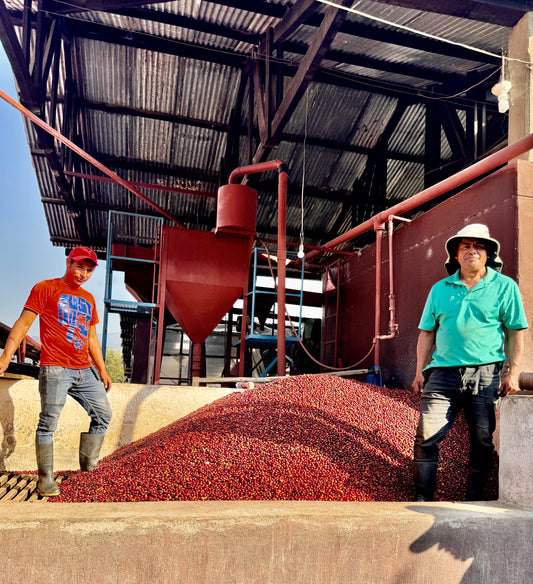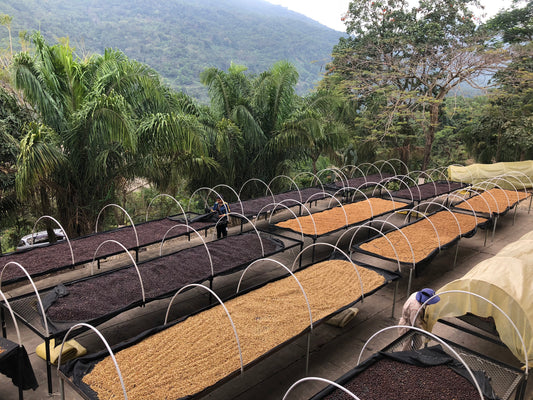Coffee Processing Methods Explained : Washed, Natural, Anaerobic and Honey

Are you starting to get serious about specialty coffee? It’s essential that you learn about all the different coffee processing methods.
You know when you look at a bag of coffee and see “black honey” or “anaerobic natural”? Our aim is to help you end this head-scratchery so you can be confident about your coffee knowledge.
We did a previous blog about coffee processing before, but we wanted to revisit it more in-depth and add some newer processes to the mix. Understanding how your coffee was processed helps you understand why it tastes the way it does.

What is coffee processing?
In a nutshell, coffee processing is what gets done to the coffee cherry after it’s been picked off the tree and sorted. After harvesting and picking the ripest cherries, the producer needs to decide what to do with the cherries.
Coffee is the seed inside of a cherry. Sure, you could simply remove the cherry and discard it immediately. That is a coffee processing method in itself (more on that later). But the cherry itself is sweet and fruity, and it can add some very interesting, complex flavours to the green beans.
In most forms of processing, a certain amount of the cherry pulp is left on the bean to ferment. Fermentation is a tricky task which can go terribly wrong and result in spoilage, but if done right, it can be magical. It requires getting the right temperature, pH level, and fermentation time.

The anatomy of a coffee cherry
Let’s run through the anatomy of a coffee cherry so that when we throw around terms like “mucilage” and “skin,” you know what we’re talking about.
-
Skin
The skin or the “cascara” of the cherry is the outermost layer of the fruit.
-
Pulp
The pulp refers to the overall flesh of the fruit, just under the skin.
-
Mucilage
The mucilage is a very specific part of the pulp–it’s the sticky, slippery layer that covers the seed.
-
Parchment
The parchment is the papery layer of the seed that covers and protects the seed. It comes off naturally while being roasted.
-
Seed
The seed of the coffee cherry is essentially the green bean.
To better visualize the anatomy of a coffee cherry, check out this resource.
Let’s run through the most popular coffee processing methods.
Wet process coffee
Wet process coffee, or “washed” process, is a process where the pulp and mucilage are removed from the seed as quickly as possible.
First, the coffee cherries are placed in a de-pulping machine. Second, the seeds ferment briefly to soften the mucilage just enough to facilitate easy removal. Third, the seeds are soaked in water and agitated to remove the sticky mucilage layer. Finally, the seeds are laid flat on beds to sun-dry completely before being packed and shipped.
This is a very popular method of processing because it lends a very clean taste that allows the natural acidity to shine.
Honey process coffee
In the honey process, the skin and pulp are removed from the seed, but the mucilage is left on the seed during fermentation.
There are 3 different levels of honey process coffee: yellow, red, and black. The darker the colour, the longer the fermentation, and the stronger the flavour. Let’s explore these sub-processes more in-depth.
-
Yellow honey process coffee
The mucilage is left on the seed, and the beans are laid out on large mats to sun dry. Yellow honey process coffee is lightly sweet and fruity with a clean profile, similar to wet process, but fruitier.
-
Red honey process coffee
The mucilage-covered seeds are fermented slightly. The seeds are piled on top of each other to facilitate fermentation, and then raked into a flat layer to dry. Red honey coffee tastes sweet and fruity.
-
Black honey process coffee
In this process, the mucilage-covered seeds are fermented the longest. The beans are piled on top of each other, with a longer fermentation than red honey. Black honey process coffee tastes winey and boozy thanks to the longer fermentation, with ripe fruit notes.
Natural process coffee
Natural process coffee is where the whole cherry is left intact on the seed during fermentation. This includes the skin, pulp, and mucilage–nothing is removed.
The beans lie in the sun on raised beds, while constantly being turned. This prevents rotting and spoiling the entire batch of coffee. Once the beans are fully dried, the dried cherries are hulled off to extract the green beans.
Natural process coffee has a very fruity, molasses-y flavour that a lot of people are drawn to. It’s common to taste fruity notes like blueberry, strawberry, and raspberry, with a pleasant acidity.
The natural process is popular in coffee-growing countries where clean water isn’t an abundant resource. You’ll tend to see natural process coffee from countries like Ethiopia where there isn’t a huge supply of clean water.
Anaerobic process coffee
The anaerobic process is a newer process that’s quite tricky and time-consuming. When done properly, it can have incredibly exciting, exotic flavours like tropical fruit and spice.
Anaerobic means “oxygen deprived.” The intact coffee cherries are placed in large barrels with water and sealed from oxygen for 48 to 72 hours. They ferment without oxygen, which imparts a completely different flavour from natural or honey processing. After fermentation, the pulp and mucilage are removed and the beans are laid to dry completely in the sun.

Wet hull process
Not to be confused with “wet process,” the wet hull process is a less common type of coffee processing. Also known as “giling basah,” this coffee process method is mainly practised in Indonesia. In this process, the parchment is removed from the seed before the bean dries completely.
Coffee that’s been wet hulled tends to have rich earthy, smokey, dirty flavours, with little to no sweetness or acidity. These coffees tend to taste good when roasted dark, which eliminates some of their unpleasant flavours. This allows the desirable flavours, like earth and smoke, to shine.
Trust the process
Coffee processing methods have a huge impact on the flavour of your coffee. If you’re a coffee lover and want to learn more about coffee, it is essential that you learn about coffee processing methods. It can help you understand why your coffee tastes the way it does.
Want to experience coffee processes for yourself? Shop our Kenya Fully Washed, our West Coast Honey Processed, or our Gunsmoke Fully Washed & Wet Hulled coffees now!






